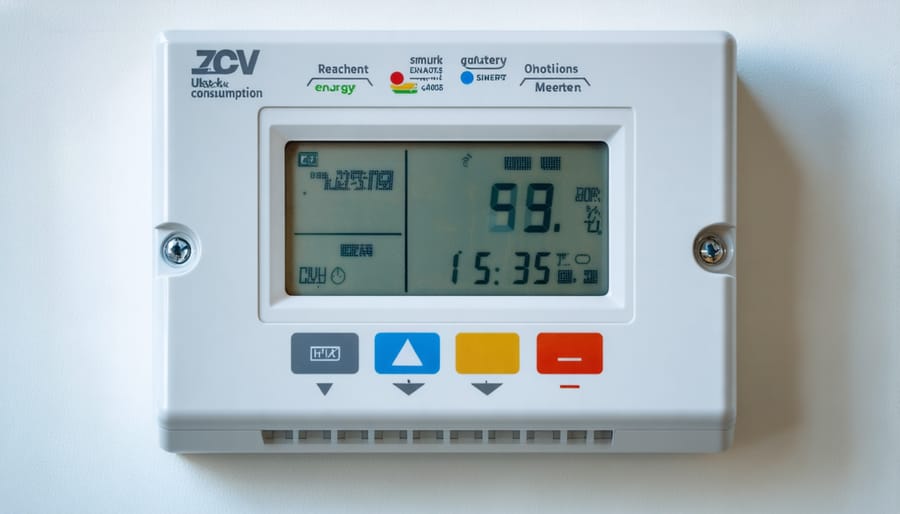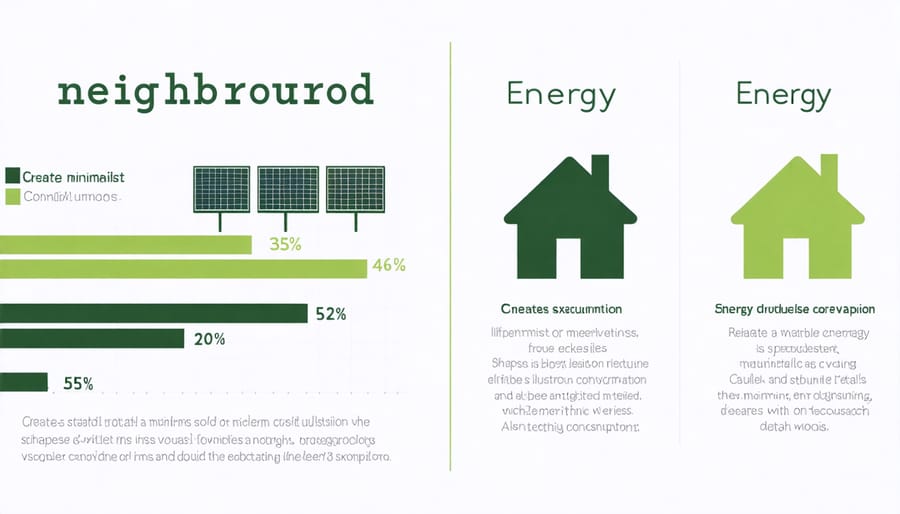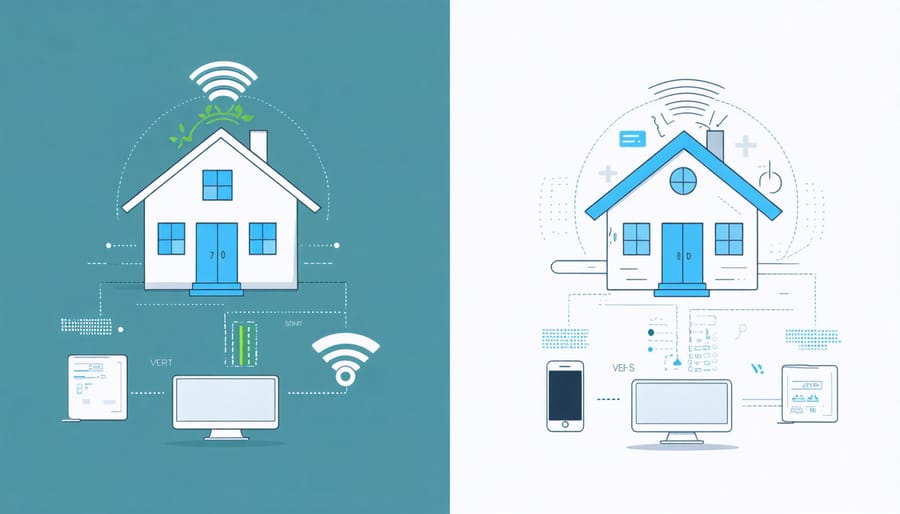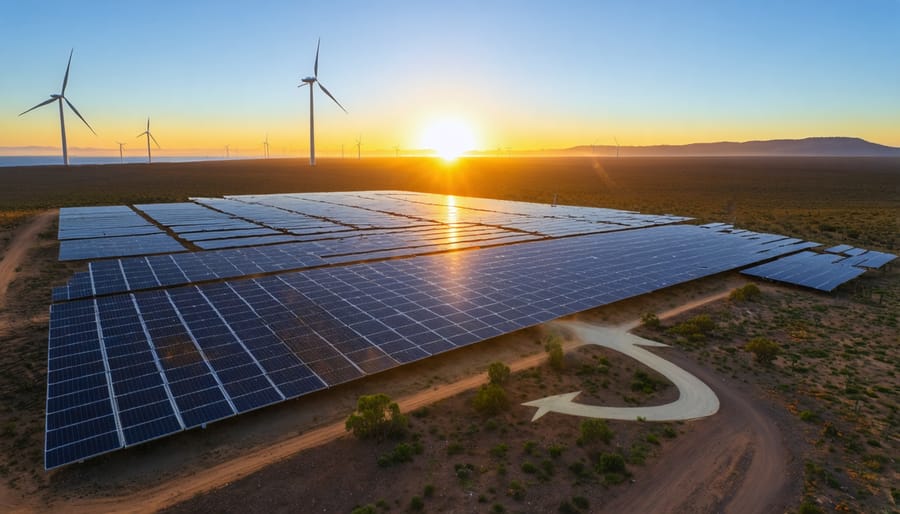As Australia stands at the crossroads of an energy revolution, sustainable power solutions are no longer just alternatives – they’re imperatives. From the sun-drenched outback to wind-swept coastal regions, our continent possesses some of the world’s richest renewable energy resources, waiting to be harnessed. The transition to sustainable energy isn’t just about environmental stewardship; it’s about creating resilient communities, fostering economic growth, and securing our energy independence for generations to come.
The global energy landscape is transforming at an unprecedented pace, with renewable technologies becoming increasingly efficient and affordable. Solar panels that once seemed like luxury investments now power millions of Australian homes, while wind farms generate enough electricity to support entire cities. Innovation in energy storage solutions, particularly advanced battery systems, is rapidly solving the intermittency challenges that once held renewable energy back.
This paradigm shift presents both opportunities and challenges. As we navigate this crucial transition, understanding our sustainable energy options becomes essential for homeowners, businesses, and policymakers alike. By making informed choices today, we can create a cleaner, more sustainable tomorrow while maintaining the reliability and affordability that our energy system demands.
The Psychology Behind Sustainable Energy Decisions
Why We Make Poor Energy Choices
Despite our best intentions, humans often make energy choices that don’t align with our environmental values or financial interests. Research shows how social norms influence energy decisions, leading us to stick with familiar but less sustainable options.
The “set and forget” mentality plays a significant role, where we continue with existing energy arrangements rather than exploring better alternatives. This status quo bias is particularly strong in Australia, where many households maintain traditional energy systems despite having access to abundant solar resources.
Another common barrier is present bias – our tendency to prioritize immediate benefits over long-term gains. While sustainable energy solutions often offer substantial savings over time, the upfront costs can feel daunting. This explains why many Aussies hesitate to invest in solar panels or energy-efficient appliances, even when the long-term benefits clearly outweigh initial expenses.
Information overload also contributes to decision paralysis. With rapidly evolving technology and numerous options available, many feel overwhelmed and default to familiar choices rather than making informed decisions about sustainable alternatives.
The Power of Default Options
In the realm of sustainable energy adoption, default options wield remarkable influence over consumer choices. Research shows that when renewable energy is presented as the standard option, participation rates can increase by up to 90% compared to opt-in programs. This phenomenon, known as the “green default effect,” leverages our natural tendency to stick with preset choices.
Australian energy providers have successfully implemented these proven behavior change strategies in various communities. For instance, when several Queensland utilities made GreenPower the default choice for new customers while maintaining the option to switch to conventional power, renewable energy adoption doubled within the first year.
The power of defaults extends beyond individual households to organizational settings. Companies that preset their building management systems to eco-friendly modes and configure equipment to energy-saving settings by default have reported energy savings of up to 25%. This simple yet effective approach demonstrates how thoughtful default options can create significant positive environmental impact while requiring minimal effort from end-users.
By strategically designing default choices, we can make sustainable energy consumption the path of least resistance, naturally guiding consumers toward greener alternatives.
Practical Nudges for Better Energy Choices
Smart Meters and Real-Time Feedback
Smart meters have revolutionized how Australians interact with their energy consumption, creating a powerful feedback loop that drives more sustainable behavior. By providing real-time data on energy usage, these intelligent devices transform abstract concepts into tangible, actionable information that households and businesses can use to make informed decisions.
Research shows that when people receive immediate feedback about their energy consumption, they typically reduce their usage by 5-15%. This “see-and-save” approach works because it connects our actions directly to their consequences, making energy use visible and manageable. Through user-friendly displays and engaging sustainability tools, consumers can track their usage patterns, identify energy-hungry appliances, and spot opportunities for savings.
In Queensland, for example, households with smart meters reported significant behavioral changes after installation. Simple actions like turning off unused appliances or adjusting air conditioning settings became automatic responses once people could see their immediate impact on consumption. Many users describe the experience as “playing a game” where reducing energy usage becomes a rewarding challenge.
The benefits extend beyond individual households. Businesses using smart meters often discover previously hidden patterns of energy waste, leading to substantial cost savings and reduced environmental impact. This real-time feedback system has become a cornerstone of Australia’s push toward more sustainable energy practices, making energy consciousness an integral part of daily life.

Social Comparison Reports
One of the most powerful tools for promoting energy conservation is the use of neighborhood comparison reports. These reports leverage our natural tendency to measure ourselves against our peers, creating a friendly competitive spirit that drives positive change. Research has consistently shown strong social comparison effectiveness in motivating households to reduce their energy consumption.
In Australian communities where these reports have been implemented, households receiving regular updates about their energy usage compared to their neighbors have shown remarkable improvements. For example, in Brisbane’s western suburbs, a pilot program revealed that homes receiving monthly comparison reports reduced their energy consumption by an average of 6.5% within six months.
The success of these reports lies in their presentation. They typically include easy-to-understand graphics showing how a household’s energy use compares to similar homes in the area, along with personalized tips for improvement. The reports often feature a friendly “smiley face” for households performing better than average, creating positive reinforcement.
What makes these comparisons particularly effective is their local focus. When people see that their immediate neighbors are achieving better energy efficiency, it creates an achievable standard and demonstrates that sustainable practices are both practical and beneficial. This approach has proven especially successful in tight-knit Australian communities where social connections are strong and environmental consciousness is growing.

Green Energy Default Programs
Several Australian communities have demonstrated remarkable success with green energy default programs, where residents are automatically enrolled in renewable energy plans while maintaining the freedom to opt out. The city of Melbourne’s initiative stands out as a shining example, with an impressive 90% of customers choosing to remain with the renewable energy option after implementation.
In South Australia, the Adelaide Solar Citizens program transformed the region’s energy landscape by making solar power the default choice for new housing developments. The program achieved an 85% retention rate, effectively reducing carbon emissions while keeping energy costs stable for residents.
The Hunter Valley region showcased another successful approach by partnering with local energy providers to establish a community-wide renewable energy default scheme. Within its first year, the program helped reduce regional carbon emissions by 45,000 tonnes while maintaining high customer satisfaction rates.
These success stories share common elements: transparent communication, competitive pricing, and strong community engagement. Local councils found that by framing renewable energy as the standard choice rather than an alternative option, they effectively normalized sustainable practices.
The Byron Bay Shire’s green energy initiative particularly resonates with residents by emphasizing local energy independence and environmental stewardship. Their program boasts a remarkable 95% retention rate, proving that when implemented thoughtfully, default renewable programs can create lasting positive change in communities.
Making Sustainable Energy the Easy Choice
Home Energy Solutions That Work
Australian homeowners are increasingly discovering that sustainable energy solutions aren’t just good for the planet – they’re great for the wallet too. By implementing a combination of smart technologies and simple habits, households across the country are slashing their energy bills while reducing their carbon footprint.
Solar panel systems remain the cornerstone of home energy solutions, with many Aussie families reporting savings of up to 85% on their electricity bills after installation. When paired with battery storage, these systems provide reliable power even after the sun sets, offering true energy independence.
Smart home automation systems are proving to be game-changers. Motion sensors that automatically control lighting, smart thermostats that optimize heating and cooling, and energy monitoring systems that track usage patterns are helping families make informed decisions about their energy consumption.
Heat pumps for water heating and space conditioning are gaining traction as efficient alternatives to traditional systems. These clever devices use minimal electricity to move heat rather than generate it, resulting in significant energy savings.
Simple yet effective solutions include LED lighting upgrades, which use up to 75% less energy than traditional bulbs, and proper insulation, which can reduce heating and cooling needs by up to 40%. Even strategic placement of trees for natural shading can make a substantial difference in home energy efficiency.
Many Australian households are also embracing the “set and forget” approach with programmable timers for appliances and automated blind systems that adjust based on sunlight levels. These passive solutions work continuously in the background, ensuring optimal energy usage without requiring constant attention.
Remember, the most successful home energy solutions combine multiple approaches, creating a comprehensive system that works together to maximize efficiency and minimize waste.

Business Implementation Strategies
Organizations can effectively implement sustainable energy nudges through a systematic, multi-layered approach. Start by conducting an energy audit to establish baseline consumption patterns and identify key areas for improvement. This data-driven foundation helps create targeted interventions that resonate with stakeholders.
Setting up a green team is essential for successful implementation. This cross-functional group should include representatives from various departments to ensure broad buy-in and diverse perspectives. The team can champion initiatives and maintain momentum throughout the implementation process.
Visual cues play a crucial role in behavior change. Install real-time energy monitors in prominent locations to display current consumption levels and savings achieved. These displays can create healthy competition between departments or teams, driving engagement and sustained participation.
Make sustainable choices the default option. This could mean programming office equipment to energy-saving modes, setting default temperatures for heating and cooling systems, or automatically scheduling equipment shutdowns during non-business hours.
Recognition and rewards systems help maintain motivation. Consider implementing a points-based program where departments earn rewards for meeting energy-saving targets. Share success stories through internal communications channels to celebrate achievements and inspire others.
Regular feedback loops are vital for program success. Conduct monthly reviews of energy consumption data, gather employee feedback, and adjust strategies accordingly. This iterative approach ensures the program remains relevant and effective.
Partner with local sustainability experts and energy providers to access additional resources and expertise. Many utility companies offer free energy assessments and implementation support, which can enhance your organization’s efforts while minimizing costs.
Remember to document and share your journey. Success stories inspire other organizations and contribute to broader community awareness about sustainable energy practices.
The Future of Energy Choice Architecture
The landscape of energy choice architecture is rapidly evolving, with innovative technologies and approaches reshaping how we encourage sustainable energy adoption. Smart meters with real-time feedback displays are becoming increasingly sophisticated, showing not just energy consumption but also corresponding environmental impacts through engaging visualizations. These systems are being enhanced with artificial intelligence to provide personalized recommendations, making sustainable choices more intuitive for consumers.
Digital platforms are emerging as powerful tools for community-based energy initiatives. Virtual power plants are connecting households across Australian neighborhoods, allowing them to share and optimize their renewable energy usage. These platforms often incorporate gamification elements, turning sustainable energy choices into engaging social experiences.
Mobile applications are becoming more sophisticated in their approach to energy nudging. New apps can now predict peak demand periods and automatically adjust smart home devices to optimize energy use while maintaining comfort. Some innovative programs even offer micro-rewards for sustainable choices, creating immediate positive reinforcement for green energy decisions.
Blockchain technology is being integrated into energy choice architecture, enabling transparent tracking of renewable energy sources and creating new opportunities for peer-to-peer energy trading. This technology is particularly promising for regional communities, where direct energy sharing between neighbors can enhance grid resilience and promote local renewable energy production.
Looking ahead, augmented reality (AR) applications are showing promise in helping consumers visualize their energy choices and their impact. Imagine pointing your smartphone at your solar panels and seeing real-time production data, weather forecasts, and optimization suggestions overlaid in your view.
The future also holds exciting possibilities for behavioral science integration. Advanced algorithms are being developed to understand and predict energy consumption patterns, allowing for more sophisticated and personalized nudging strategies. These systems will be able to adapt their approach based on individual responses, creating a more effective and engaging experience for users committed to sustainable energy choices.
The transition to sustainable energy is not just a distant goal – it’s a journey we can begin today. By implementing thoughtful nudges in our homes, workplaces, and communities, we can create lasting change that benefits both our environment and economy. From smart meters that provide real-time feedback to green energy defaults in power plans, these subtle yet powerful interventions have proven effective in shifting behaviour towards more sustainable choices.
The success stories across Australia demonstrate that when we combine behavioural insights with renewable energy solutions, remarkable transformations are possible. Whether you’re a homeowner, business leader, or policymaker, you have the power to contribute to this positive change. Start by implementing one or two nudges in your sphere of influence, measure their impact, and build upon your successes.
Let’s work together to create an energy future that’s clean, sustainable, and prosperous for all Australians. The time to act is now.

